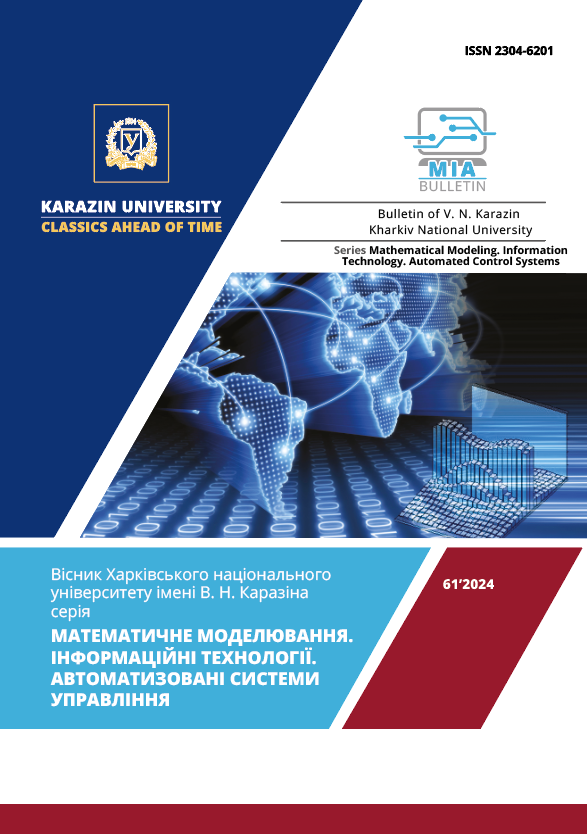Виникнення «інтелекту» у саморухомих ботів
Анотація
Актуальність. Наразі є дуже перспективним розвиток сучасного напрямку досліджень поведінки та властивостей активної матерії, яка відповідає колективній поведінці саморухомих складових. Така активна матерія широко поширена в природі та використовується у різних сучасних технологіях.
Мета. Провести дослідження колективної поведінки рухомих ботів у простому лабіринті та визначити характерні закономірності у виході цих частинок з лабіринту зі збільшення їх кількості.
Методи дослідження. Для виконання досліджень були створені рухомі боти та проведені експерименти по їх поведінці в лабіринті. Фіксація їх положень та взаємодії фіксувались відео записом, обробка якого дозволила отримати необхідні дані.
Результати. Виявлено існування оптимальної кількості ботів у лабіринті, для яких середній час виходу з лабіринту мінімальний. Визначена залежність ймовірності виходу ботів з лабіринту теж має не монотонний характер та існує кількість ботів за якої ця імовірність мінімальна. Визначено, що при наявних дванадцятьох ботах у лабіринті середній час виходу мінімальний, як і ймовірність виходу. Таким чином, при цій кількості, з лабіринту швидко виходить менша частина ботів. Запропоновано кількісну міру інтелектуальності ботів — коефіцієнт інтелекту. Існує оптимальна кількість ботів, яка має максимальну міру «інтелекту» по відношенню до задачі виходу ботів з лабіринту. Зменшення, як і збільшення кількості ботів веде до зменшення «інтелекту» колективу ботів. Міра «інтелекту» колективу ботів перевищує «інтелект» одного бота.
Висновки. В роботі було розглянуто вихід зграй саморухомих ботів з лабіринту та характерні числові характеристики, які дозволили визначити головні залежності їх поведінки.
Завантаження
Посилання
/Посилання
S.Ramaswamy, «The Mechanics and Statistics of Active Matter». Annual Review of Condensed Matter Physics, 2010. p.323–345. URL: https://www.annualreviews.org/doi/abs/10.1146/annurev-conmatphys-070909-104101
Aoki A simulation study on the schooling mechanism in fish. Bulletin of the Japanese Society of Scientific Fisheries, 48(8), 1982. p.1081-1088. URL: https://www.jstage.jst.go.jp/article/suisan1932/48/8/48_8_1081/_article
W. Reynolds. Flocks, herds, and schools, A distributed behavioral model, In Computer Graphics, pages 25-34, 1987. URL: https://dl.acm.org/doi/10.1145/37402.37406
T.Vicsek, A.Zafeiris, Collective motion. Physics Reports. 517 (3), 2012. p.71–140. URL: https://arxiv.org/abs/1010.5017
M.Rubenstein, A.Cornejo, R.Nagpal, Robotics. Programmable self-assembly in a thousand-robot swarm, Science, 345(6198), p.795-9, 2014. URL: https://pubmed.ncbi.nlm.nih.gov/25124435/
Shannon C.E., Presentation of a maze-solving machine, Cybernetics. Trans of the 8th conf. of the Josian Macy Jr. Found (Ed-H. v. Foerster), Nl, 1952. p.173-180. URL: https://www.kuenzigbooks.com/pages/books/28624/claude-shannon-elwood/presentation-of-a-maze-solving-machine-reproduced-paper
K.Dоpp, Automaten in labirinthen I, Electronische Informationsverarbeitung und Kybernetik, v.7, No.2, 1971. p.79-94. URL: https://dblp.org/rec/journals/eik/Dopp71
K.Dоpp, Automaten in labirinthen II, Electronische Informationsverarbeitung und Kybernetik, v.7, No.3, 1971. p.167-190. URL: https://dblp.org/rec/journals/eik/Dopp71a
H.Muller, Automata catching labyrinths with at most three components, Elektronische Informationsverarbeitung und Kybernetik, v.15, No.1/2, 1979. p.3-9. URL: https://dblp.org/rec/journals/eik/Muller79
H.Antelmann, L.Budach, H.A.Rollik, On universale traps, Elektronische Informationsverarbeitung und Kybernetik, v.15, No.3, 1979. p.123-131. URL: https://dblp.org/rec/journals/eik/AntelmannBR79
G.Asser, Bemerkungen zum labirinth-problem, Elektronische Informationsverarbeitung und Kybernetik, v.13, No.4,5, 1977. p.203-216. URL: https://dblp.org/rec/journals/eik/Asser77
R.Danecki, M.Karpinski, Decidability results on plane automata searching mazes, Proc. 2nd Int. FCT’7-9 Berlin: Conf. Akademie Verlag, 1979. p.84-91. URL: https://dblp.org/rec/conf/fct/DaneckiK79
M.Blum , C.Hewitt, Automata on a 2-dimensional tape, IEEE Conference Record, 8th Annual Symposium on Switching and Automata Theory, 1967. p.155-160. URL: https://doi.org/10.1109/FOCS.1967.6
D.M. Naplekov, V. V. Yanovsky, Thin structure of transit time distributions of open billiards, Phys. Rev. E 97, 012213(8), 2018. URL: https://doi.org/10.1103/PhysRevE.97.012213
D. Yamada, T. Hondou, and M. Sano, Coherent dynamics of an asymmetric particle in a vertically vibrating bed, Phys. Rev. E 67, 040301R (2003). URL: https://doi.org/10.1103/PhysRevE.67.040301
J.Deseigne, O.Dauchot, R.Chaté, Collective Motion of Vibrated Polar Disks, Physical Review Letters. 105 (9), 2010. URL: https://doi.org/10.1103/PhysRevLett.105.098001
Rita L. Atkinson, Richard C. Atkinson, Edward E. Smith, Daryl J. Bem, Susan Nolen-Hoeksema. "Hilgard’s Introduction to Psychology. History, Theory, Research, and Applications", 13th ed., 2000. URL: https://invent.ilmkidunya.com/images/Section/introduction-to-psychology-css-psychology-book.pdf
S. Ramaswamy, «The Mechanics and Statistics of Active Matter». Annual Review of Condensed Matter Physics, 2010. p.323–345. URL: https://www.annualreviews.org/doi/abs/10.1146/annurev-conmatphys-070909-104101
Aoki A simulation study on the schooling mechanism in fish. Bulletin of the Japanese Society of Scientific Fisheries, 48(8), 1982. p.1081-1088. URL: https://www.jstage.jst.go.jp/article/suisan1932/48/8/48_8_1081/_article
W. Reynolds. Flocks, herds, and schools, A distributed behavioral model, In Computer Graphics, pages 25-34, 1987. URL: https://dl.acm.org/doi/10.1145/37402.37406
T.Vicsek, A.Zafeiris, Collective motion. Physics Reports. 517 (3), 2012. p.71–140. URL: https://arxiv.org/abs/1010.5017
M.Rubenstein, A.Cornejo, R.Nagpal, Robotics. Programmable self-assembly in a thousand-robot swarm, Science, 345(6198), p.795-9, 2014. URL: https://pubmed.ncbi.nlm.nih.gov/25124435/
Shannon C.E., Presentation of a maze-solving machine, Cybernetics. Trans of the 8th conf. of the Josian Macy Jr. Found (Ed-H. v. Foerster), Nl, 1952. p.173-180. URL: https://www.kuenzigbooks.com/pages/books/28624/claude-shannon-elwood/presentation-of-a-maze-solving-machine-reproduced-paper
K.Dоpp, Automaten in labirinthen I, Electronische Informationsverarbeitung und Kybernetik, v.7, No.2, 1971. p.79-94. URL: https://dblp.org/rec/journals/eik/Dopp71
K.Dоpp, Automaten in labirinthen II, Electronische Informationsverarbeitung und Kybernetik, v.7, No.3, 1971. p.167-190. URL: https://dblp.org/rec/journals/eik/Dopp71a
H.Muller, Automata catching labyrinths with at most three components, Elektronische Informationsverarbeitung und Kybernetik, v.15, No.1/2, 1979. p.3-9. URL: https://dblp.org/rec/journals/eik/Muller79
H.Antelmann, L.Budach, H.A.Rollik, On universale traps, Elektronische Informationsverarbeitung und Kybernetik, v.15, No.3, 1979. p.123-131. URL: https://dblp.org/rec/journals/eik/AntelmannBR79
G.Asser, Bemerkungen zum labirinth-problem, Elektronische Informationsverarbeitung und Kybernetik, v.13, No.4,5, 1977. p.203-216. URL: https://dblp.org/rec/journals/eik/Asser77
R.Danecki, M.Karpinski, Decidability results on plane automata searching mazes, Proc. 2nd Int. FCT’7-9 Berlin: Conf. Akademie Verlag, 1979. p.84-91. URL: https://dblp.org/rec/conf/fct/DaneckiK79
M.Blum , C.Hewitt, Automata on a 2-dimensional tape, IEEE Conference Record, 8th Annual Symposium on Switching and Automata Theory, 1967. p.155-160. URL: https://doi.org/10.1109/FOCS.1967.6
D.M. Naplekov, V. V. Yanovsky, Thin structure of transit time distributions of open billiards, Phys. Rev. E 97, 012213(8), 2018. URL: https://doi.org/10.1103/PhysRevE.97.012213
D. Yamada, T. Hondou, and M. Sano, Coherent dynamics of an asymmetric particle in a vertically vibrating bed, Phys. Rev. E 67, 040301R (2003). URL: https://doi.org/10.1103/PhysRevE.67.040301
J.Deseigne, O.Dauchot, R.Chaté, Collective Motion of Vibrated Polar Disks, Physical Review Letters. 105 (9), 2010. URL: https://doi.org/10.1103/PhysRevLett.105.098001
Rita L. Atkinson, Richard C. Atkinson, Edward E. Smith, Daryl J. Bem, Susan Nolen-Hoeksema. "Hilgard’s Introduction to Psychology. History, Theory, Research, and Applications", 13th ed., 2000. URL: https://invent.ilmkidunya.com/images/Section/introduction-to-psychology-css-psychology-book.pdf




